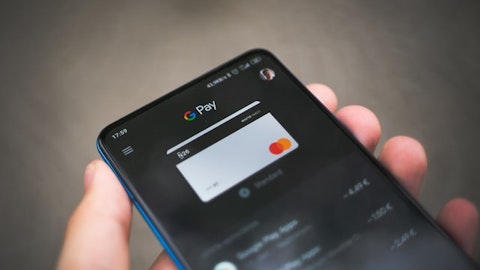Affirm Holdings, Inc. (NASDAQ:AFRM) Q2 2024 Earnings Call Transcript February 8, 2024
Affirm Holdings, Inc. misses on earnings expectations. Reported EPS is $-0.54 EPS, expectations were $0.08. Affirm Holdings, Inc. isn’t one of the 30 most popular stocks among hedge funds at the end of the third quarter (see the details here).
Operator: Good afternoon. Welcome to the Affirm Holdings, Inc. Second Quarter Fiscal 2024 Earnings Call. Following the speakers’ remarks, we will open the lines for your questions. As a reminder, this conference call is being recorded, and a replay of the call will be available on our Investor Relations website for a reasonable period of time after the call. I’d now like to turn the call over to Zane Keller, Director, Investor Relations. Thank you. You may begin.
Zane Keller: Thank you, operator. Before we begin, I would like to remind everyone listening that today’s call may contain forward-looking statements. These forward-looking statements are subject to numerous risks and uncertainties including those set forth in our filings with the SEC, which are available on our Investor Relations website. Actual results may differ materially from any forward-looking statements that we make today. These forward-looking statements speak only as of today, and the company does not assume any obligation or intent to update them, except as required by law. In addition, today’s call may include non-GAAP financial measures. These measures should be considered as a supplement to and not a substitute for GAAP financial measures.

For historical non-GAAP financial measures, reconciliations to the most directly comparable GAAP measures can be found in our earnings supplement slide deck which is available on our Investor Relations website. Hosting today’s call with me are Max Levchin, Affirm’s Founder and Chief Executive Officer; and Michael Linford, a firm’s Chief Financial Officer. In line with our practice in prior quarters, we will begin with brief opening remarks from Max before proceeding immediately into questions and answers. On that note, I will turn the call over to Max to begin.
Max Levchin: Thank you, Zane. Thank you all for joining us today. We’re excited to share the results of another great quarter. As is our custom, the better the results, the fewer words we used to comment on them. This time around, I feel good enough to go directly to the Q&A. Back to you, Zane.
Zane Keller: Thank you, Max. With that, we will now take your questions. Operator, please open the line for our first question.
See also 15 Blue-Collar Jobs That Pay at Least $75,000 a Year and 15 Most Respected Countries in Asia.
Q&A Session
Follow Affirm Holdings Inc. (NASDAQ:AFRM)
Follow Affirm Holdings Inc. (NASDAQ:AFRM)
Operator: Thank you. We will now be conducting a question-and-answer session. [Operator Instructions] Our first question comes from the line of Ramsey El-Assal with Barclays. Please proceed with your question.
Ramsey El-Assal: Hi. Thanks for taking my question this evening. I was wondering, if you could help us think through RLTC for the remaining two quarters of the year. Sort of what are the drivers, puts and takes, variables that could impact our RLTC and drive underperformance or outperformance. How should we think about those kind of variables?
Michael Linford: Yeah. I think, obviously, if you’re thinking in terms of percentage of GMV, there’s a number of factors, mix and macro at the top of the list. If you’re thinking about total dollars then GMV on the platform was going to be the biggest driver of results there. In terms of the RLTC rate, the take rate on a percentage of GMV, it’s really mix and macro. So the mix of business across our merchant base and the products that we offer there. And from a macro perspective, everything going on with consumers and rates would be there. We really like the environment we’re in right now. That’s why we’ve updated our full year guidance like we have. And so we feel good about the back half of the year. RLTC margins as a percentage of GMV and feel good about that because of the macro environment that we’re in.
And we — as per the usual, we take the current macro signals current levels of unemployment, current forward curve and bake goes into our assumptions. But obviously, there are scenarios where those could move one way or the other, that would change the outcome for us.
Ramsey El-Assal: Okay. And a follow-up for me. On Slide 10, where you list out your GMV vertical mix, it looks like general merchandise has picked up quite a bit from travel and ticketing or travel and ticketing has gone down and general merchandise gone up. Are there any drivers to call out there? And I guess, more broadly, can you just comment on performance across key verticals in there?
Michael Linford: So travel and ticketing is a very seasonal category. So a lot of folks book summer vacation travel in the first two calendar quarters, last two fiscal quarters, of our year, and it tends to be lowest in terms of bookings in calendar quarters like Q2. And so we think there’s a huge seasonality factor there. And for general merchandise, some of our largest merchant enterprise partners fall in that bucket. And as we continue to scale those, we will see lots of purchases there, and it’s not unusual for that to be a category that spikes in and around holiday season has a lot of holiday shopping is done in those channels.
Ramsey El-Assal: Got it. Makes perfect sense. Thank you.
Operator: Thank you. Our next question comes from the line of Andrew Jeffrey with Truist Securities. Please proceed with your question.
Andrew Jeffrey: Hi. Appreciate you taking the question. Max, brevity is indeed the sister of talent, I’ll make that very clear. So I’ve got a couple of questions just on GMV growth and tender share. As I recall, you’ve tightened the credit box about a year ago, and obviously, the back half of the fiscal year looks strong. Can you comment either Max or Michael, just on kind of how underwriting and risk are factoring into that strength? And then the corollary, I guess, or the follow-on would be around tender share of your enterprise customers, and it appeared to be elevated during the holidays, and I just wonder if that’s a sign of accelerating tender share to come or aspirational end or share growth?
Max Levchin: Appreciate the comments, first of all. The underwriting settings, so the single most I would say, accelerated change we’ve conducted to our, as we call it, Box, it was really more a 1.5 years ago than a year ago. April of ’22 is when we saw real stress on the consumer, and we reacted to that sort of within the next 60 days or so. We’ve since really not done an enormous amount of significant steering. We changed marginal cutoffs on a merchant-by-merchant category by category, product by product basis all the time and also change things like allowed terms as durations required down payments, etc. So we managed credit very, very actively since sort of the beginning of time for us but there’s not been a major change to our posture in the last 1.5 years.
The numbers that we printed just now are not an accident. We drove them to be what they are very, very deliberately. And I don’t want anybody to sort of assume that we’re hands off and the numbers just print themselves. It’s a lot of work, and we care quite a lot where they end up. We have certain expectations we set with capital markets, and we intend to continue delivering those expectations. And so that’s first and foremost. And that governs a lot of our metrics that put to that. The tender share — share of wallet as we go on internally has done really well over the holidays. We’ve generally been gaining wallet share, although the stories are different category. And in some cases, merchant to merchant. Feel very good about some of the things that we announced.
Obviously, offline. We were not a noticeable player until recently in between the card and some of the online — offline self-checkout kiosks really powerful. And then just sort of call out one, particularly strong performance over the holidays, especially and overall in the last quarter, Shopify has just continued to perform extraordinarily. The growth of that particular partnership is accelerating three plus years into the partnership. That set of products grew about twice the speed of the rest of Affirm. And so it’s just been a story of success to success. And we still have a lot of things that we have not scaled out. They have their own offline aspirations that we’re obviously very excited to be a part of, etc. And so it’s a little bit of a — and I’m giving a very long-winded answer here, but frequency for us is being where consumer shops.
And share of tender comes as a consequence of being available and being able to support the various consumer needs that as we encounter them.
Michael Linford: And the only thing I’d add is we did with the 36% APR cap that we were able to get in place, we were able to be more expansionary in a number of places that is completely done now. And so we wouldn’t expect any more volume benefit there, although there is still some margin benefit, we think that will come as the program continues to roll out and scale but we wouldn’t expect any more volume there because of 36%.
Andrew Jeffrey: Thank you. Appreciate it.
Operator: Thank you. Our next question comes from the line of Reggie Smith with JPMorgan. Please proceed with your question.
Reginald Smith: Good afternoon and congrats on the quarter. I guess you kept your comments short. But I guess where were you most surprised and this is a pretty big beat. And then I had a follow-up after that.
Max Levchin: We try to run a tight ship, so surprises are rarely a welcome thing and if they are to the good. I think, I already called that out, but I thought Shopify as a company, years to have done a fantastic job with their products, and we stand to support our partners there and have done it all together. Let’s see what other surprises. Don’t like surprises, Reggie. I feel like, anytime somebody surprise me, I’m not going to like the outcome. Actually, I’ll give you one very surprising fact, which is a little bit of an inside view, but we had very noticeably accelerated our ability to ship software and I had anticipated some of that, but I’m quite surprised about how productive the teams have been on the engineering side, on the product side and design side, sort of percolates down to revenue.
So generally speaking, I expected that we would rally around the goals, especially from sort of the low point of this time last year. But the if it’s a turnaround, it’s a much faster and more aggressive turnaround than I expected.
Reginald Smith: Got it. And then just looking at the seasonal patterns of your margins, the back half of the year tends to be better than the front half of the year. And when I look at your full year guidance for your operating margin, I guess it implies in the third quarter, I think it implies a pretty sequential increase in and expenses below the RLTC line? Like, what’s driving that and kind of where should we see that show up? Is it a marketing thing? Is it technology? My rough math was almost like $20 million of sequential increase to — I’m not sure if that’s right or not. But if you can comment on that a little bit, that would be helpful.
Michael Linford: Yeah. We don’t provide a specific guidance number for there. So sometimes the way in which we build our guidance can lead to a little bit of exaggeration on that as you calculate it. But that’s right. And there’s a couple of factors to think about. Firstly, we – and this will sound very trivial, but I promise you it does actually end up becoming pretty big. We do expect there to be a lot more payroll tax associated with stock-based compensation in our first quarter, both because people have reset their tax obligations to – with the new year, but also because the share price is higher. And both those two things will create a little bit of the sequential bump from quarter-to-quarter. And then we remain really excited about the opportunities that are ahead for us.
And so we’re continuing to be thoughtful around where we should be adding resources to go build new products and chase the new opportunities. And I think the strength in this quarter’s results with respect to our unit economics and operating efficiency, give us license to be willing to add a little operating expense, whereas I think we’ve been very cautious to do that until we could demonstrate it.
Reginald Smith: Understood. Congratulations. Great quarter.
Michael Linford: Thank you.
Operator: Thank you. Our next question comes from the line of Dan Dolev with Mizuho. Please proceed with your question.




